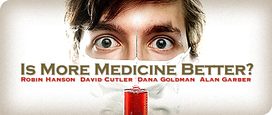Lead Essay
In this month’s lead essay, the iconoclastic George Mason economist Robin Hanson argues that “our main problem in health policy is a huge overemphasis on medicine.” Hanson points to a spate of studies — especially the huge RAND health insurance experiment — to show that “in the aggregate, variations in medical spending usually show no statistically significant medical effect on health.” Hanson lays down the gauntlet and “dares” other health policy experts to publicly agree or disagree with this seemingly well-confirmed claim and its implications for policy. For Hanson, those implications are clear: “Cutting half of medical spending would seem to cost little in health, and yet would free up vast resources for other health and utility gains.”
Response Essays
Harvard’s David M. Cutler agrees with Robin Hanson’s claim that “a lot of medical spending doesn’t add much value.” However, he is “surprised by Hanson’s argument that this hasn’t been much noted,” pointing to major media coverage of this point and to his own work. According to Cutler, Hanson’s argument is “too simplistic,” suggesting that people in 1975 were better off with half today’s average medical spending. New technologies are both very successful and very expensive, and Cutler argues this extra cost is worth it. Citing research that demand-side approaches to cutting wasteful spending, such as raising consumer prices, are ineffective, Cutler plumps for a supply-side approach: “invest in information technology, monitor what physicians do, and pay providers more for better care than for less good care.”
Robin Hanson is half right, says Dana Goldman, the RAND Chair of Health Economics and Founding Director of RAND’s Bing Center for Health Economics. Medicine can only do so much, and most recent increases in longevity are the effect of healthier habits and living conditions, Goldman says. However, Goldman notes, the RAND Health Insurance Experiment, which Hanson leans on, is more than thirty years old, and many new therapies have emerged since then. In particular, new drugs have been shown to have a large impact on health. Patients required to pay for more of their care often cut out what they neeed, not what they don’t. Improved living conditions may do more for future health than more medicine, Goldman suspects. “But it may also turn out society should be spending more, not less, on medical care — just doing so in a more prudent manner.”
According to Alan Garber, the Henry J. Kaiser, Jr. Professor at Stanford, “Hanson’s diagnosis … is not particularly controversial. His solution is.” Efforts to trim excess medical spending must confront the highly variable benefits of certain medical treatments. Garber argues that Hanson’s eagerness to implement cuts, largely regardless of the details, risks cutting high-value treatments along with lower-value ones. According to Garber, what we need, first, is more and better information about the value of particular interventions. Second, we need incentives not to guide people away from overconsumption generally, but to guide them away from low-value care. Third, we need to increase the sensitivity of consumers to the costs of their health care by exposing them more to prices. Improved information and education, Garber says, will help consumers choose wisely.

